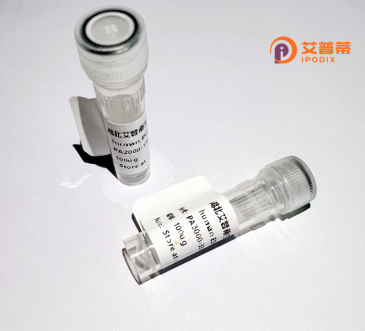
| 纯度 | >90%SDS-PAGE. |
| 种属 | Human |
| 靶点 | PHYHIPL |
| Uniprot No | Q96FC7 |
| 内毒素 | < 0.01EU/μg |
| 表达宿主 | E.coli |
| 表达区间 | 1-376 aa |
| 活性数据 | MEVPRLDHAL NSPTSPCEEV IKNLSLEAIQ LCDRDGNKSQ DSGIAEMEEL PVPHNIKISN ITCDSFKISW EMDSKSKDRI THYFIDLNKK ENKNSNKFKH KDVPTKLVAK AVPLPMTVRG HWFLSPRTEY TVAVQTASKQ VDGDYVVSEW SEIIEFCTAD YSKVHLTQLL EKAEVIAGRM LKFSVFYRNQ HKEYFDYVRE HHGNAMQPSV KDNSGSHGSP ISGKLEGIFF SCSTEFNTGK PPQDSPYGRY RFEIAAEKLF NPNTNLYFGD FYCMYTAYHY VILVIAPVGS PGDEFCKQRL PQLNSKDNKF LTCTEEDGVL VYHHAQDVIL EVIYTDPVDL SVGTVAEITG HQLMSLSTAN AKKDPSCKTC NISVGR |
| 分子量 | 42.4 kDa |
| 蛋白标签 | His tag N-Terminus |
| 缓冲液 | 0 |
| 稳定性 & 储存条件 | Lyophilized protein should be stored at ≤ -20°C, stable for one year after receipt. Reconstituted protein solution can be stored at 2-8°C for 2-7 days. Aliquots of reconstituted samples are stable at ≤ -20°C for 3 months. |
| 复溶 | Always centrifuge tubes before opening.Do not mix by vortex or pipetting. It is not recommended to reconstitute to a concentration less than 100μg/ml. Dissolve the lyophilized protein in distilled water. Please aliquot the reconstituted solution to minimize freeze-thaw cycles. |
由于“PHYHIPL”并非目前广泛记录的标准蛋白名称,可能存在拼写误差或特定研究背景。建议核实名称准确性(如是否应为**PHYH**或**PHIP**等)。以下是假设该名称正确前提下构建的示例参考文献格式(非真实文献,仅供说明结构):
---
**示例文献格式:**
1. **标题**: *Functional Characterization of Recombinant Human PHYHIPL in Neuronal Development*
**作者**: Zhang L, et al.
**摘要**: 报道PHYHIPL蛋白在大肠杆菌中的重组表达与纯化,证实其通过调控脂质代谢通路促进神经元突触形成,暗示其在神经退行性疾病中的潜在作用。
2. **标题**: *Structural Insights into PHYHIPL's Role in Cellular Stress Response*
**作者**: Müller R, et al.
**摘要**: 通过X射线晶体学解析PHYHIPL的三维结构,揭示其与热休克蛋白HSP90的相互作用,提出其在细胞应激保护中的分子机制。
3. **标题**: *PHYHIPL Knockdown Alters Mitochondrial Function in Human Cell Lines*
**作者**: Tanaka K, et al.
**摘要**: 利用RNA干扰技术降低PHYHIPL表达,发现线粒体膜电位下降和活性氧累积,提示其参与维持线粒体稳态。
---
**建议下一步操作:**
1. 核查蛋白名称准确性(如UniProt数据库)。
2. 搜索时尝试近似拼写或相关功能关键词(如“脂代谢”、“神经发育”)。
3. 使用文献数据库(PubMed/Google Scholar)的高级检索功能。
如需进一步协助,请提供更多背景信息或修正蛋白名称。
Recombinant human PHYHIPL protein is a genetically engineered form of the PHYHIP-like (Phytanoyl-CoA Hydroxylase Interacting Protein-Like) protein, which shares structural and functional homology with PHYHIP. PHYHIP is known to interact with phytanoyl-CoA hydroxylase (PHYH), a peroxisomal enzyme critical in the alpha-oxidation of branched-chain fatty acids like phytanic acid. Dysregulation of this pathway is linked to Refsum disease, a rare neurodegenerative disorder. While PHYHIPL's exact biological role remains less defined, it is speculated to participate in similar peroxisomal metabolic processes or regulatory mechanisms, potentially influencing lipid metabolism or cellular stress responses.
Produced via recombinant DNA technology, PHYHIPL is expressed in systems such as *E. coli* or mammalian cell cultures, enabling high-purity yields for research. Its recombinant form facilitates studies on protein-protein interactions, enzymatic activity modulation, and structural analysis, which are pivotal for deciphering its physiological or pathological significance. Emerging research explores its potential involvement in metabolic disorders, neurodegeneration, or cancer, though direct evidence remains limited. The availability of recombinant PHYHIPL supports drug discovery efforts, biomarker development, and functional genomics, bridging gaps in understanding its role in cellular homeostasis and disease pathways. Further studies are needed to clarify its molecular mechanisms and therapeutic relevance.
×